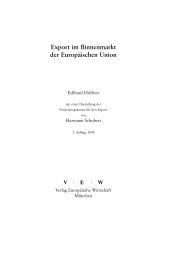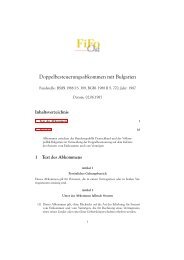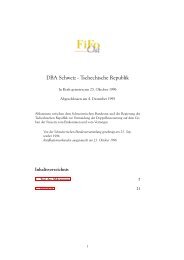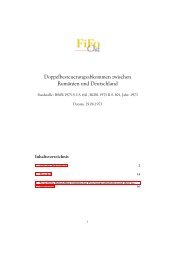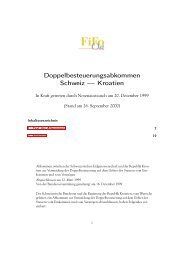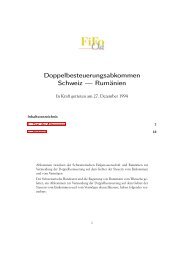Introduction - FiFo Ost
Introduction - FiFo Ost
Introduction - FiFo Ost
Create successful ePaper yourself
Turn your PDF publications into a flip-book with our unique Google optimized e-Paper software.
Major sectors of the economy<br />
The Croatian enterprise sector has been undergoing a difficult transition, however, many sectors managed to avoid or<br />
overcome crises. Some large enterprises, (e.g. Victor Lenac (shipbuilding), Pliva (pharmaceuticals), and Podravka (food<br />
industry) managed to restructure successfully and increase sales. However, the disruption caused by the war, the loss<br />
of traditional Yugoslav export markets, and structural problems led to a decline of some traditional sectors, such as base<br />
metals, textiles, beverages and food. Tourism, which accounts for 3.4 per cent of GDP, delivered a record performance in 2000.<br />
In recent years, many Croatian enterprises have started to expand in Yugoslav markets.<br />
Shipbuilding<br />
The restructuring and privatisation of the shipbuilding industry,<br />
which is a major concern of the government, started to gain<br />
momentum in 2000. The sector represents immense potential.<br />
In the 1980s Croatia was the world's third largest shipbuilder,<br />
but since then the sector has declined substantially. The<br />
industry was privatised through voucher sales in the early<br />
1990s, but the majority of shares are still owned by various<br />
state controlled privatisation funds. Limited restructuring<br />
efforts in the mid 1990s did not bring positive results, as the<br />
industry stayed dependent on state support and benefits from<br />
various guarantees and direct subsidies.<br />
In September 2000, the government adopted stabilising<br />
measures for five shipbuilding yards, concentrating on five of<br />
the six yards operated under Hrvatska Brodogradnja-Jadranbrod<br />
(HBJ), a state-owned umbrella company. The five yards are as<br />
follows: Uljanik (in Pula), 3 Maj and Kraljevica (both near<br />
Rijeka), and, Brodotrogir and Brodosplit (both in central<br />
Dalmatia). All these yards currently have significant<br />
indebtedness. Some have a negative net worth and on average<br />
operate at only 50 per cent of capacity. The rehabilitation<br />
programme aims to lead to successful privatisation by the end<br />
of 2001. A total of HRK 4.2 billion will be invested by 2003,<br />
including HRK 1.5 billion (€ 192 million) in subsidies for the<br />
industry over the next three years. Secondly, budgetary claims<br />
worth HRK 490 million (€ 62 million) for 1999 have been<br />
written off. The plan entails a 10 per cent subsidy on every<br />
order, an amount that is now customary in Europe, given the<br />
intensity of competition from the Far East. Fortunately, the<br />
stabilisation process coincides with an expected loss of<br />
competitive pressure from west European yards, as an EU ban<br />
on shipbuilding subsidies will come into force in 2001. This<br />
window of opportunity could provide additional manoeuvring<br />
room for restructuring the yards and reducing their debts.<br />
Currently, Victor Lenac (VL), the single privately owned Croatian<br />
yard, is the only profitable firm in the industry, and good proof<br />
of the capability of Croatian shipbuilding. Analysts attribute the<br />
company's remarkable success to its sound management and<br />
its specialisation in custom-building ships to order. VL was<br />
privatised in 1992 and has been floated on the Zagreb Stock<br />
Exchange. Its present shareholders include the Dutch company<br />
Belegginsmaatschappij Ella III, Italian shipping company Motiron<br />
Shipping Corporation, Raiffeisenbank Austria and the IFC.<br />
Besides traditional low-margin ship repair, where competition<br />
with lower-cost countries is intense, much of the yard's profit<br />
comes from building offshore installations, mainly for oil and<br />
gas companies, and from conducting complex ship conversions.<br />
Around 95 per cent of the yard's revenues come from foreign<br />
markets. The international contracts are largely generated by<br />
a co-operation agreement with the ThyssenKrupp group<br />
(Germany), whose portfolio includes two German shipyards.<br />
In 2000, the main shareholders invested US$ 58 million into<br />
new production facilities.<br />
Besides state managed restructuring, there have also been<br />
recent signs of market-driven concentration in the industry,<br />
as three yards, all located in the Rijeka region, signed a<br />
co-operation agreement. VL, 3 May and Kraljevica agreed to<br />
co-operate on procurement, sales, organisation of quality<br />
assurance systems and workforce training. The deal is likely<br />
to be a first step towards a merger, as VL has expressed<br />
interest in participating in the upcoming privatisation of the<br />
two other yards.<br />
Telecommunications<br />
Italy<br />
Austria<br />
Slovenia<br />
Adriatic Sea<br />
Croatia<br />
Hungary<br />
Bosnia-<br />
Herzegovina<br />
Yugoslavia<br />
Progress in the reconstruction and expansion of telecoms<br />
infrastructure has recently accelerated. The state-owned<br />
monopoly, Hrvatske Telekomunikacije (Croatian Telecom,<br />
or HT), is moving towards further privatisation, and plans<br />
to liberalise the market are under way. The government<br />
is currently preparing amendments to the 1999 Law on<br />
telecommunications to introduce competition in the fixed<br />
network and remove HT's monopoly on fixed telephony<br />
from the beginning of 2003.<br />
Croatia Investment Profile 11







